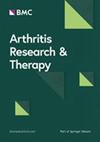神经网络分析作为系统性硬化症患者白莫硫地尔试验的一种新的皮肤结果
IF 4.6
2区 医学
Q1 Medicine
引用次数: 0
摘要
改良罗德南皮肤评分(mRSS)是衡量系统性硬化症(SSc)皮肤厚度的指标,与炎症和血管病变无关。此前,我们展示了基于神经网络的数字病理学应用于系统性硬化症皮肤活检作为定量结果的潜力。在这里,我们利用深度学习和临床试验活检组织学分析来解读人工智能(AI)"看到 "的 SSc 皮肤特征。年龄≤6岁的弥漫性皮肤SSc成人参加了一项贝卢莫司地(一种Rho-associated coiled-coil containing protein kinase 2 (ROCK2)抑制剂)的开放标签试验。参与者在第 0 周、第 24 周和第 52 周接受了连续的 mRSS 和手臂活检。两位双盲皮肤病理学家对染色切片(如 Masson 三色、苏木精和伊红、CD3、α-平滑肌肌动蛋白)进行评分,以检测 16 个已发表的 SSc 皮肤病理参数。我们应用深度学习模型生成 QIF 签名/活组织检查并获得 "纤维化评分"。我们确定了纤维化评分与 mRSS 之间的相关性(Spearman 相关性),以及纤维化评分和 mRSS 与组织学参数之间的相关性[几率比(OR)]。由于研究提前结束,只有十名患者入选,其中五名患者由于固定问题无法获得活检样本。十名参与者的 mRSS 变化(0-52 W)的中位数和四分位数间距(IQR)为-2(-9-7.5),五名有活检结果的参与者的中位数和四分位数间距(IQR)为-2.5(-11-7.5)。纤维化评分与 mRSS 之间的相关性为 R = 0.3;p = 0.674。每 1 单位 mRSS 变化(0-52 W),相关变化最大的组织学参数为(OR,95% CI,p 值):毛细血管扩张(2.01,[(1.31-3.07],0.001),血管周围 CD3 +(0.99,[0.97-1.02],0.015),CD3 + 中 CD8 + 的百分比(0.95,[0.89-1.01],0.031)。同样,纤维化评分每变化 1 个单位,变化最大的参数是(OR,P 值):透明胶原(1.1,[1.04 - 1.16],< 0.001)、皮下(SC)脂肪减少(1.47,[1.19-1.81],<0.001)、内膜增厚(1.21,[1.06-1.38],0.005)和肾小球夹层(1.14,[1-1.31],0.046)。贝卢莫司地与无临床意义的 mRSS 改善相关。与纤维化评分变化显著相关的组织学特征(如透明胶原、SC 脂肪脱失)不同于与 mRSS 变化相关的组织学特征(如毛细血管扩张和血管周围 CD3 +)。这些数据表明,将 AI 应用于 SSc 活检可能有助于量化除皮肤厚度以外的 SSc 病理特征。本文章由计算机程序翻译,如有差异,请以英文原文为准。
Neural network analysis as a novel skin outcome in a trial of belumosudil in patients with systemic sclerosis
The modified Rodnan skin score (mRSS), a measure of systemic sclerosis (SSc) skin thickness, is agnostic to inflammation and vasculopathy. Previously, we demonstrated the potential of neural network-based digital pathology applied to SSc skin biopsies as a quantitative outcome. Here, we leverage deep learning and histologic analyses of clinical trial biopsies to decipher SSc skin features ‘seen’ by artificial intelligence (AI). Adults with diffuse cutaneous SSc ≤ 6 years were enrolled in an open-label trial of belumosudil [a Rho-associated coiled-coil containing protein kinase 2 (ROCK2) inhibitor]. Participants underwent serial mRSS and arm biopsies at week (W) 0, 24 and 52. Two blinded dermatopathologists scored stained sections (e.g., Masson’s trichrome, hematoxylin and eosin, CD3, α-smooth muscle actin) for 16 published SSc dermal pathological parameters. We applied our deep learning model to generate QIF signatures/biopsy and obtain ‘Fibrosis Scores’. Associations between Fibrosis Score and mRSS (Spearman correlation), and between Fibrosis Score and mRSS versus histologic parameters [odds ratios (OR)], were determined. Only ten patients were enrolled due to early study termination, and of those, five had available biopsies due to fixation issues. Median, interquartile range (IQR) for mRSS change (0–52 W) for the ten participants was -2 (-9—7.5) and for the five with biopsies was -2.5 (-11—7.5). The correlation between Fibrosis Score and mRSS was R = 0.3; p = 0.674. Per 1-unit mRSS change (0–52 W), histologic parameters with the greatest associated changes were (OR, 95% CI, p-value): telangiectasia (2.01, [(1.31—3.07], 0.001), perivascular CD3 + (0.99, [0.97—1.02], 0.015), and % of CD8 + among CD3 + (0.95, [0.89—1.01], 0.031). Likewise, per 1-unit Fibrosis Score change, parameters with greatest changes were (OR, p-value): hyalinized collagen (1.1, [1.04 – 1.16], < 0.001), subcutaneous (SC) fat loss (1.47, [1.19—1.81], < 0.001), thickened intima (1.21, [1.06—1.38], 0.005), and eccrine entrapment (1.14, [1—1.31], 0.046). Belumosudil was associated with non-clinically meaningful mRSS improvement. The histologic features that significantly correlated with Fibrosis Score changes (e.g., hyalinized collagen, SC fat loss) were distinct from those associated with mRSS changes (e.g., telangiectasia and perivascular CD3 +). These data suggest that AI applied to SSc biopsies may be useful for quantifying pathologic features of SSc beyond skin thickness.
求助全文
通过发布文献求助,成功后即可免费获取论文全文。
去求助
来源期刊

Arthritis Research & Therapy
RHEUMATOLOGY-
CiteScore
8.60
自引率
2.00%
发文量
261
审稿时长
14 weeks
期刊介绍:
Established in 1999, Arthritis Research and Therapy is an international, open access, peer-reviewed journal, publishing original articles in the area of musculoskeletal research and therapy as well as, reviews, commentaries and reports. A major focus of the journal is on the immunologic processes leading to inflammation, damage and repair as they relate to autoimmune rheumatic and musculoskeletal conditions, and which inform the translation of this knowledge into advances in clinical care. Original basic, translational and clinical research is considered for publication along with results of early and late phase therapeutic trials, especially as they pertain to the underpinning science that informs clinical observations in interventional studies.
 求助内容:
求助内容: 应助结果提醒方式:
应助结果提醒方式:


